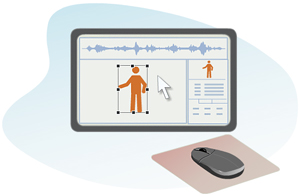 Is it better to have real people or animation in a video? Or both? Well, there’s no correct answer to that, and a lot depends on your goals, your needs and your budget. However, if you are trying to communicate your solution’s value to prospects fast, and if you are trying to explain a complicated concept — then an animated video may be the best choice. Here are four reasons why you should consider creating animated videos to use with your sales and marketing efforts.
Is it better to have real people or animation in a video? Or both? Well, there’s no correct answer to that, and a lot depends on your goals, your needs and your budget. However, if you are trying to communicate your solution’s value to prospects fast, and if you are trying to explain a complicated concept — then an animated video may be the best choice. Here are four reasons why you should consider creating animated videos to use with your sales and marketing efforts.
1. You can take things in a different direction fast

In a previous blog post, I included a short video that added simple animation and narration to an interesting illustration that appeared in a Gartner blog on the B2B technology buying process. The Gartner analyst, Hank Barnes, whose illustration it was, and made this comment:
I think most of the team is at the same “place” in the overall flow — versus some late in flow and some early . . . But their focus varies (as described) and they definitely move between streams.
So, I reworded part of the script, snipped out part, re-recorded one item, and worked with animator Tony Coccia to move some graphics around and change the animation flow. The new version took less than three hours to get online.
The point is that a little feedback from the subject matter expert could redirect this animated video very quickly and send the animation in a new direction. I think the result is a much tighter video that communicates the concept more clearly — and more correctly.
The reason we like working this way is that most people in the technology field — for that matter, most people in business generally — cannot imagine how a video will look and sound until they see it. Rearranging sequences and synching up new words with new graphics is a lot easier when you are working with animation. This quick redirection of a “finished” video would not have been so quick and easy if the message were delivered by a talking head, an on-camera presenter, or in any format other than animation or motion graphics.
2. Animation simplifies complex subjects
Besides agility, another big advantage of (simple) animation is that it can make complicated subjects look simple. Even when the subject itself is complication, animating it forces the writer and animator to simplify — so the viewer can follow an argument, and think, instead of just listening. In this example, the video is saying that network complexity is a bigger problem than you may think it is, but it builds up the idea of complexity in simple-looking steps.
3. Animation aids concision
Obviously real people can give a more credible testimonial than an animated gecko or other critter. Sincerity is great, but, unfortunately, few real men are men of few words. Same with women. Real people generally aren’t very economical with words, and (especially if you stick a camera in their face) tend to back and fill and hem and haw.
So, putting words into the mouths of a narrator and/or animated character is the most efficient and effective way to work to a word count — which is essential if you’re trying to make a video of a specified length and keep the messaging (and messagers) on track.
4. Animation frees the imagination

Finally, animation opens up infinite story-telling possibilities. If the video is about a storage solution, why not make it a warehouse story like the video to the right?

If it’s about wasted storage, make it about solid waste like the video to your right. It doesn’t take Disney or Pixar animation to get people thinking in new ways. It just takes a little animation and a little imagination.



